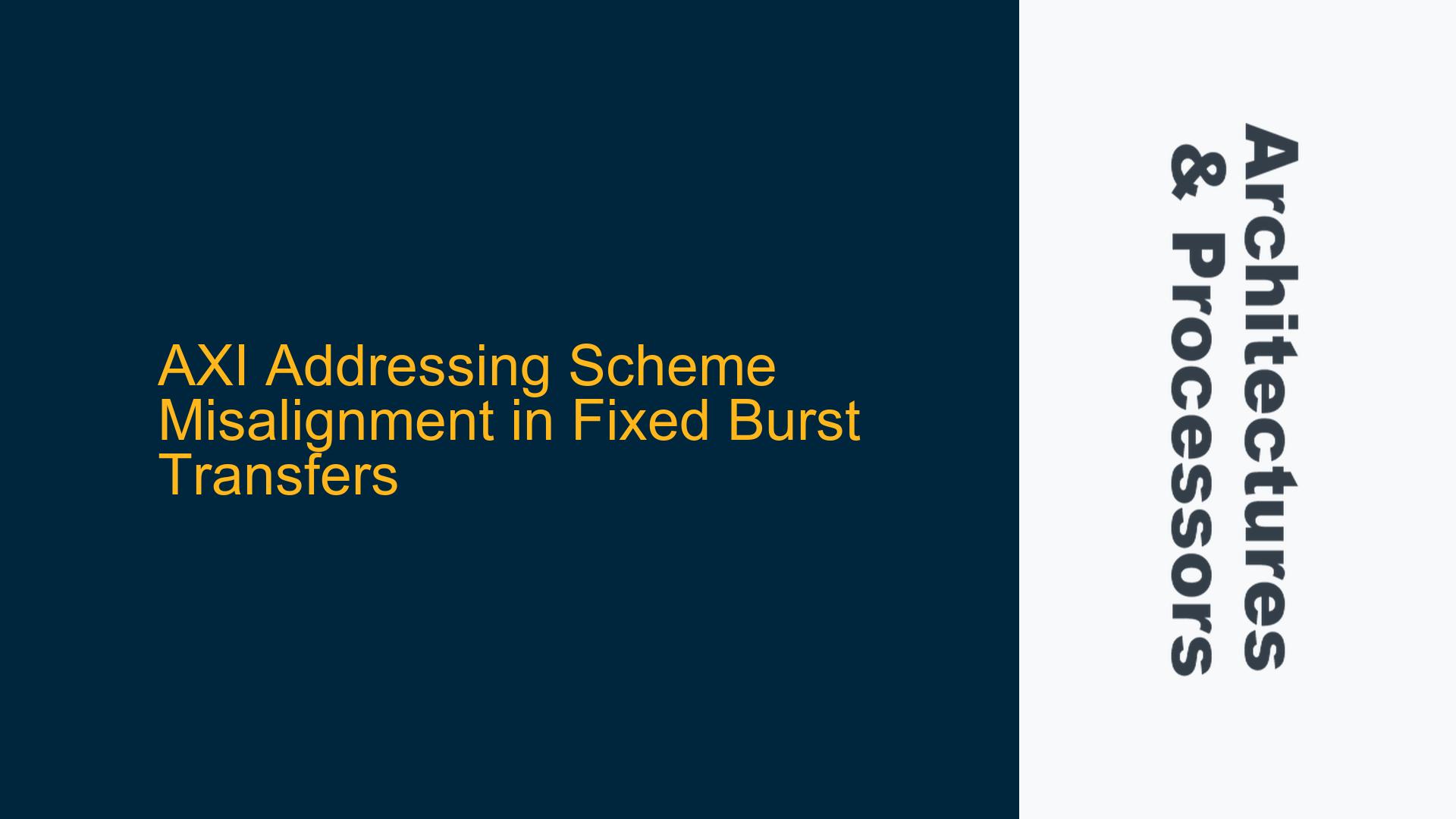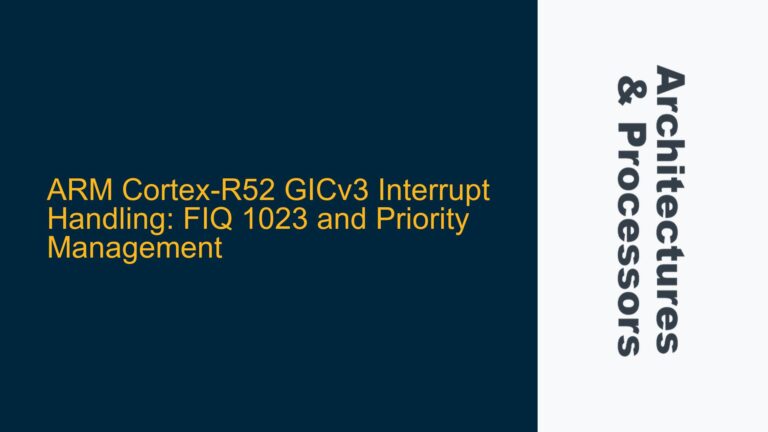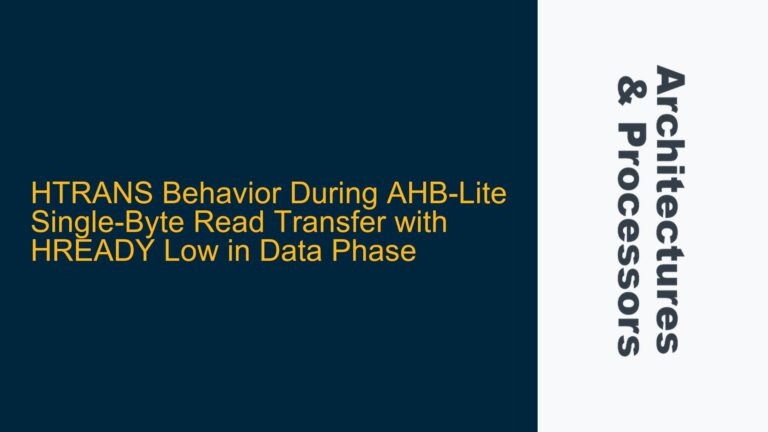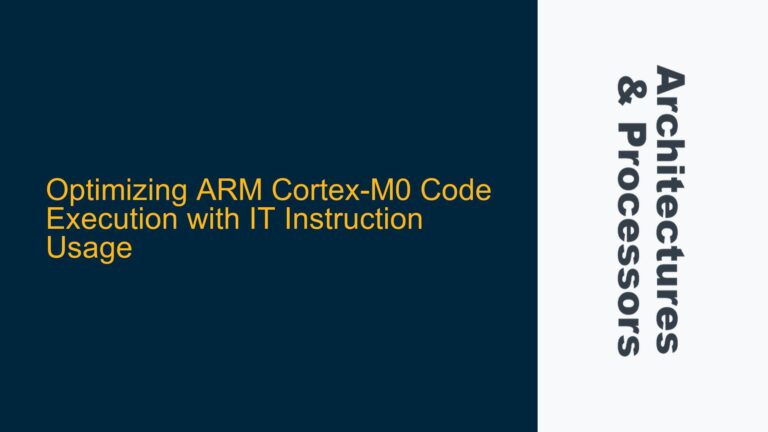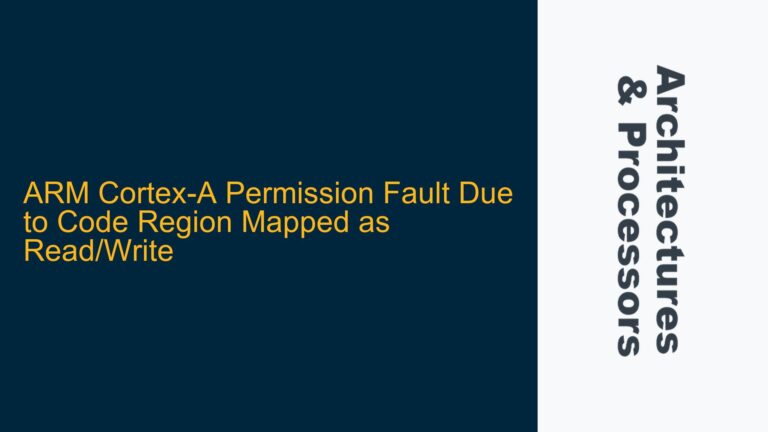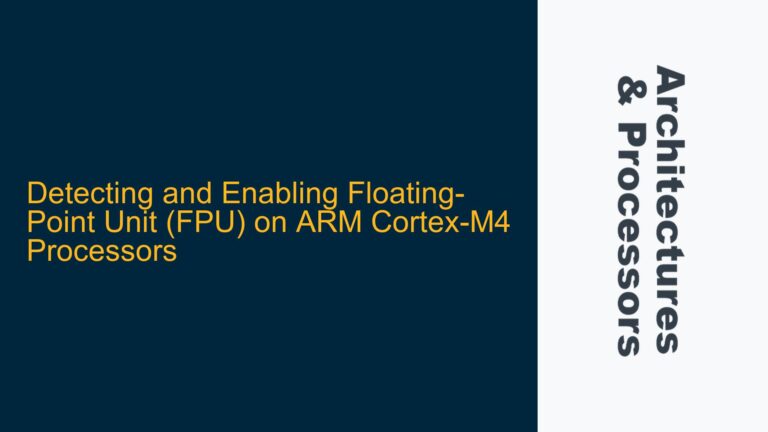ARM AXI Protocol Fixed Burst Misalignment with AWSIZE and AWADDR
The ARM AXI (Advanced eXtensible Interface) protocol is a widely used on-chip communication standard for high-performance embedded systems. It provides a flexible and efficient way to transfer data between masters and slaves in a system-on-chip (SoC). However, one of the more nuanced aspects of the AXI protocol is how it handles addressing and data transfers, particularly in scenarios involving unaligned addresses and fixed burst types. This issue arises when the AWSIZE (transfer size) and AWADDR (address) parameters are not aligned, leading to inefficient data transfers and potential confusion in implementation.
In the context of the AXI protocol, AWSIZE defines the maximum number of bytes that can be transferred in each beat of a burst transaction. AWADDR specifies the starting address for the transaction. When these two parameters are not aligned—meaning the starting address is not a multiple of the transfer size—the AXI protocol must handle the misalignment in a way that adheres to its rules. This becomes particularly relevant in fixed burst transactions, where the address does not increment between beats. The combination of an unaligned address and a fixed burst type can result in suboptimal data transfer efficiency, as only a subset of the available byte lanes may be used for each transfer.
For example, consider a scenario where DATA_WIDTH is 64 bits, AWSIZE is set to 1 (indicating 2-byte transfers), and AWADDR is set to 0x03 (an unaligned address). In this case, the WSTRB (write strobe) signal will only enable a single byte lane (e.g., 00001000) for each transfer, even though the transfer size is 2 bytes. This results in only 1 byte being transferred per beat, despite the request for 2 bytes. This behavior is a direct consequence of the AXI protocol’s handling of unaligned addresses in fixed burst transactions.
Misaligned AWADDR and Fixed Burst Constraints in AXI Transfers
The root cause of this issue lies in the interaction between the AXI protocol’s addressing scheme and the constraints imposed by fixed burst transactions. When AWSIZE and AWADDR are misaligned, the AXI protocol must ensure that only valid byte lanes are used for data transfer. This is particularly important in fixed burst transactions, where the address remains constant across all beats of the burst. The protocol’s handling of this scenario is governed by the following principles:
-
AWSIZE and AWADDR Alignment: AWSIZE determines the maximum number of bytes that can be transferred in each beat, while AWADDR specifies the starting address. When AWADDR is not aligned with AWSIZE, the protocol restricts the usable byte lanes to those that fall within the valid address range for each beat. In the case of AWSIZE=1 (2 bytes) and AWADDR=0x03, the valid byte lane is limited to the one corresponding to address 0x03.
-
Fixed Burst Behavior: In fixed burst transactions, the address does not increment between beats. This means that the misalignment present in the first beat persists throughout the entire burst. As a result, the same subset of byte lanes is used for each transfer, leading to inefficient data transfer. For example, if AWADDR=0x03 and AWSIZE=1, the WSTRB signal will remain 00001000 for all four beats of an AWLEN=3 transaction.
-
WSTRB Signal Usage: The WSTRB signal is used to indicate which byte lanes contain valid data during a write transaction. When AWADDR is misaligned with AWSIZE, the WSTRB signal must reflect the valid byte lanes for each beat. In the case of AWSIZE=1 and AWADDR=0x03, the WSTRB signal will be 00001000 for each beat, indicating that only the byte at address 0x03 is valid.
-
Burst Type Implications: The AXI protocol supports three burst types: FIXED, INCR, and WRAP. FIXED bursts are the most restrictive in terms of addressing, as the address remains constant throughout the burst. INCR bursts allow the address to increment between beats, which can mitigate the impact of misalignment after the first beat. WRAP bursts require aligned addresses and are not compatible with misaligned transfers.
Optimizing AXI Transfers with Proper Addressing and Burst Configuration
To address the issue of misaligned AWADDR and fixed burst constraints, it is essential to understand the AXI protocol’s addressing scheme and how to configure burst transactions for optimal performance. The following steps and solutions can help mitigate the impact of misalignment and ensure efficient data transfers:
-
Align AWADDR with AWSIZE: The most straightforward solution is to ensure that AWADDR is aligned with AWSIZE. This means that the starting address should be a multiple of the transfer size. For example, if AWSIZE=1 (2 bytes), AWADDR should be aligned to a 2-byte boundary (e.g., 0x00, 0x02, 0x04, etc.). This ensures that all byte lanes specified by AWSIZE are valid for each transfer.
-
Use INCR Bursts for Unaligned Addresses: If alignment is not possible, consider using INCR bursts instead of FIXED bursts. INCR bursts allow the address to increment between beats, which can help mitigate the impact of misalignment after the first beat. For example, if AWADDR=0x03 and AWSIZE=1, the first beat will use WSTRB=00001000, but subsequent beats will use WSTRB=00010000, 00100000, and 01000000, allowing for full utilization of the available byte lanes.
-
Adjust AWSIZE for Optimal Transfer Efficiency: In some cases, it may be beneficial to adjust AWSIZE to better match the data transfer requirements. For example, if the data to be transferred is naturally aligned to 4-byte boundaries, setting AWSIZE=2 (4 bytes) can improve transfer efficiency. This approach requires careful consideration of the data layout and transfer requirements.
-
Implement Address Translation or Padding: In systems where unaligned addresses are unavoidable, consider implementing address translation or data padding to align the data with the transfer size. Address translation can be used to map unaligned addresses to aligned addresses, while data padding can be used to fill in the gaps caused by misalignment. These techniques can help improve transfer efficiency at the cost of additional complexity.
-
Monitor WSTRB Signal Usage: When dealing with misaligned addresses, it is important to monitor the WSTRB signal to ensure that only valid byte lanes are used for data transfer. This can be done by analyzing the WSTRB signal during simulation or debugging and verifying that it matches the expected pattern for each beat of the burst.
-
Leverage AXI Protocol Features: The AXI protocol provides several features that can help manage misaligned addresses and improve transfer efficiency. These include the use of cacheable and bufferable attributes, which can help optimize data transfers in systems with complex memory hierarchies. Additionally, the protocol’s support for out-of-order transactions and multiple outstanding transactions can help mitigate the impact of misalignment on overall system performance.
By following these steps and solutions, developers can effectively address the challenges posed by misaligned AWADDR and fixed burst constraints in AXI transactions. Proper configuration of the AXI protocol’s addressing and burst parameters, combined with careful monitoring and optimization, can help ensure efficient and reliable data transfers in high-performance embedded systems.
Detailed Analysis of AXI Addressing and Burst Types
To further understand the issue of misaligned AWADDR and fixed burst constraints, it is helpful to analyze the AXI protocol’s addressing scheme and burst types in detail. The following table provides a summary of the key parameters and their impact on data transfer efficiency:
| Parameter | Description | Impact on Misaligned AWADDR |
|---|---|---|
| AWSIZE | Maximum number of bytes per transfer | Determines the valid byte lanes for each transfer |
| AWADDR | Starting address for the transaction | Determines the alignment of the address with AWSIZE |
| AWBURST | Burst type (FIXED, INCR, WRAP) | Determines how the address changes between beats |
| AWLEN | Number of beats in the burst | Determines the total number of transfers in the burst |
| WSTRB | Write strobe signal indicating valid byte lanes | Reflects the valid byte lanes for each transfer based on AWSIZE and AWADDR |
The interaction between these parameters is critical to understanding how the AXI protocol handles misaligned addresses and fixed burst transactions. For example, in a FIXED burst transaction with AWSIZE=1 and AWADDR=0x03, the WSTRB signal will be 00001000 for each beat, indicating that only the byte at address 0x03 is valid. This results in inefficient data transfer, as only 1 byte is transferred per beat despite the request for 2 bytes.
In contrast, an INCR burst transaction with the same parameters would allow the address to increment between beats, enabling full utilization of the available byte lanes after the first beat. For example, the WSTRB signal would be 00001000 for the first beat, 00010000 for the second beat, 00100000 for the third beat, and 01000000 for the fourth beat. This allows for a total of 4 bytes to be transferred, matching the request for 2 bytes per beat.
Practical Considerations for AXI Implementation
When implementing AXI transactions in a real-world system, several practical considerations must be taken into account to ensure optimal performance and reliability. These include:
-
Memory Hierarchy and Cache Coherency: The AXI protocol is often used in systems with complex memory hierarchies, including caches and multiple levels of memory. In such systems, it is important to consider the impact of misaligned addresses on cache coherency and memory access patterns. Proper configuration of cacheable and bufferable attributes can help optimize data transfers and ensure coherency across the memory hierarchy.
-
System Performance and Latency: Misaligned addresses and inefficient data transfers can have a significant impact on system performance and latency. It is important to carefully analyze the data transfer requirements and configure the AXI protocol parameters to minimize latency and maximize throughput. This may involve adjusting AWSIZE, using INCR bursts, or implementing address translation or padding.
-
Debugging and Verification: Debugging and verifying AXI transactions can be challenging, particularly in systems with complex memory hierarchies and multiple masters and slaves. It is important to use simulation and debugging tools to monitor the WSTRB signal, verify the alignment of AWADDR with AWSIZE, and ensure that the burst type and length are configured correctly. This can help identify and resolve issues related to misaligned addresses and inefficient data transfers.
-
Compatibility with Other Protocols: The AXI protocol is often used in conjunction with other on-chip communication protocols, such as AHB (Advanced High-performance Bus) and APB (Advanced Peripheral Bus). It is important to ensure compatibility between these protocols and the AXI protocol, particularly in terms of addressing and data transfer efficiency. This may involve implementing bridges or adapters to translate between different protocols and ensure seamless communication.
By considering these practical considerations and following the steps and solutions outlined above, developers can effectively address the challenges posed by misaligned AWADDR and fixed burst constraints in AXI transactions. Proper configuration and optimization of the AXI protocol parameters, combined with careful monitoring and debugging, can help ensure efficient and reliable data transfers in high-performance embedded systems.
Conclusion
The issue of misaligned AWADDR and fixed burst constraints in AXI transactions is a nuanced but important aspect of the ARM AXI protocol. By understanding the interaction between AWSIZE, AWADDR, and burst types, developers can configure AXI transactions for optimal performance and efficiency. Proper alignment of AWADDR with AWSIZE, the use of INCR bursts for unaligned addresses, and careful monitoring of the WSTRB signal are key strategies for addressing this issue. Additionally, practical considerations such as memory hierarchy, system performance, and compatibility with other protocols must be taken into account to ensure reliable and efficient data transfers in real-world systems. By following the detailed analysis and solutions provided in this guide, developers can effectively troubleshoot and resolve issues related to misaligned AWADDR and fixed burst constraints in AXI transactions.
